Monitoring Vehicles on Highway by Dual-Channel φ-OTDR
Abstract
:1. Introduction
2. Experiment Setup
3. Methods of Vibration Positioning
4. Performance Tests of DC-φ-OTDR on a Campus Road
5. Vehicle Locating on a Highway
6. Conclusions
Author Contributions
Funding
Conflicts of Interest
References
- Guerrero-Ibáñez, J.; Zeadally, S.; Contreras-Castillo, J. Sensor technologies for intelligent transportation systems. Sensors 2018, 18, 1212. [Google Scholar] [CrossRef] [PubMed] [Green Version]
- Jiang, J.; Mi, C.; Wu, M.; Zhang, Z.; Feng, Y.; Mi, W. Real-time Container Truck Speed Measurement at Container Port Gates Based on the Binocular Vision Technology. J. Coast. Res. 2019, 93, 998. [Google Scholar] [CrossRef]
- Martín, F.F.; Llopis, M.V.; Rodríguez, J.C.; González, J.B.; Blanco, J.M. Low-cost open-source multifunction data acquisition system for accurate measurements. Measurement 2014, 55, 265. [Google Scholar] [CrossRef]
- Singh, G.; Majumdar, S.; Rajan, S. MapReduce-based techniques for multiple object tracking in video analytics. In Proceedings of the 2017 IEEE Smart World Ubiquitous Intelligence & Computing, Advanced & Trusted Computed, Scalable Computing & Communications, Cloud & Big Data Computing, Internet of People and Smart City Innovation (SmartWorld/SCALCOM/UIC/ATC/CBDCom/IOP/SCI), San Francisco, CA, USA, 4–8 August 2017. [Google Scholar]
- Peng, F.; Duan, N.; Rao, Y.J.; Li, J. Real-time position and speed monitoring of trains using phase-sensitive OTDR. IEEE Photon. Technol. Lett. 2014, 26, 2055–2057. [Google Scholar] [CrossRef]
- He, Z.; Liu, Q.; Fan, X.; Chen, D.; Wang, S.; Yang, G. Fiber-optic distributed acoustic sensors (DAS) and applications in railway perimeter security. Proc. SPIE 2018, 10821, 1082102. [Google Scholar]
- Zhou, Z.; Liu, W.; Huang, Y.; Wang, H.; Jianping, H.; Huang, M.; Jinping, O. Optical fiber Bragg grating sensor assembly for 3D strain monitoring and its case study in highway pavement. Mech. Syst. Signal Pr. 2012, 28, 36–49. [Google Scholar] [CrossRef]
- Masoudi, A.; Newson, T.P. High spatial resolution distributed optical fiber dynamic strain sensor with enhanced frequency and strain resolution. Opt. Lett. 2017, 42, 290–293. [Google Scholar] [CrossRef]
- Zhao, L.J.; Xu, Z.N.; Li, Y.Q.; Chen, Y.H.; Qin, H. A fast key parameter extraction algorithm for long fiber distributed sensing based on Brillouin scattering. Rev. Sci. Instrum. 2019, 90, 066101. [Google Scholar] [CrossRef]
- Peng, F.; Wu, H.; Jia, X.H.; Rao, Y.J.; Wang, Z.N.; Peng, Z.P. Ultra-long high-sensitivity phi-OTDR for high spatial resolution intrusion detection of pipelines. Opt. Express 2014, 22, 13804–13810. [Google Scholar] [CrossRef]
- Lai, M.; Peng, K.; Luo, Y.; Li, X.; Li, Y.; Ai, F.; Liu, D.; Sun, Q. Ultra-long distance distributed intrusion detecting system assisted with in-line amplification. IEEE Photonics J. 2017, 9, 1–10. [Google Scholar] [CrossRef]
- Muanenda, Y.; Faralli, S.; Oton, C.J.; Di Pasquale, F. Dynamic phase extraction in a modulated double-pulse ϕ-OTDR sensor using a stable homodyne demodulation in direct detection. Opt. Express 2018, 26, 687–701. [Google Scholar] [CrossRef] [PubMed]
- Wang, Z.; Zhang, L.; Wang, S.; Xue, N.; Peng, F.; Fan, M.; Sun, W.; Qian, X.; Rao, J.; Rao, Y. Coherent Φ-OTDR based on I/Q demodulation and homodyne detection. Opt. Express 2016, 24, 853–858. [Google Scholar] [CrossRef] [PubMed]
- Bhatta, H.D.; Costa, L.; Garcia-Ruiz, A.; Fernandez-Ruiz, M.R.; Martins, H.F.; Tur, M.; Gonzalez-Herraez, M. Dynamic measurements of 1000 microstrains using chirped-pulse phase-sensitive optical time-domain reflectometry. J. Lightwave Technol. 2019, 37, 4888–4895. [Google Scholar] [CrossRef]
- Masoudi, A.; Belal, M.; Newson, T.P. A distributed optical fibre dynamic strain sensor based on phase-OTDR. Meas. Sci. Technol. 2013, 24, 085204. [Google Scholar] [CrossRef]
- Fang, G.; Xu, T.; Feng, S.; Li, F. Phase-sensitive optical time domain reflectometer based on phase-generated carrier algorithm. J. Lightwave Technol. 2015, 33, 2811–2816. [Google Scholar] [CrossRef]
- Jiang, J.; Wang, Z.; Wang, Z.; Wu, Y.; Lin, S.; Xiong, J.; Chen, Y.; Rao, Y. Coherent Kramers-Kronig receiver for Φ-OTDR. J. Lightwave Technol. 2019, 37, 4799–4807. [Google Scholar] [CrossRef]
- Ren, M.; Lu, P.; Chen, L.; Bao, X. Theoretical and experimental analysis of Φ-OTDR based on polarization diversity detection. IEEE Photon. Lett. 2016, 28, 697–700. [Google Scholar] [CrossRef]
- Marcon, L.; Soto, M.A.; Soriano-Amat, M.; Costa, L.; Martins, H.F.; Palmieri, L.; Gonzalez-Herraez, M. Boosting the spatial resolution in chirped pulse Φ-OTDR using sub-band processing. Proc. SPIE 2019, 11199, 111991W. [Google Scholar]
- Wang, Y.; Jin, B.; Wang, Y.; Wang, D.; Liu, X.; Bai, Q. Real-Time Distributed Vibration Monitoring System Using ϕ-OTDR. IEEE Sens. J. 2017, 17, 1333–1341. [Google Scholar] [CrossRef]
- Ashry, I.; Mao, Y.; Alias, M.S.; Ng, T.K.; Hveding, F.; Arsalan, M.; Ooi, B.S. Normalized differential method for improving the signal-to-noise ratio of a distributed acoustic sensor. Appl. Opt. 2019, 58, 4933–4938. [Google Scholar] [CrossRef]
- Lu, Y.; Zhu, T.; Chen, L.; Bao, X. Distributed vibration sensor based on coherent detection of phase-OTDR. J. Lightwave Technol. 2010, 37, 3243–3249. [Google Scholar]
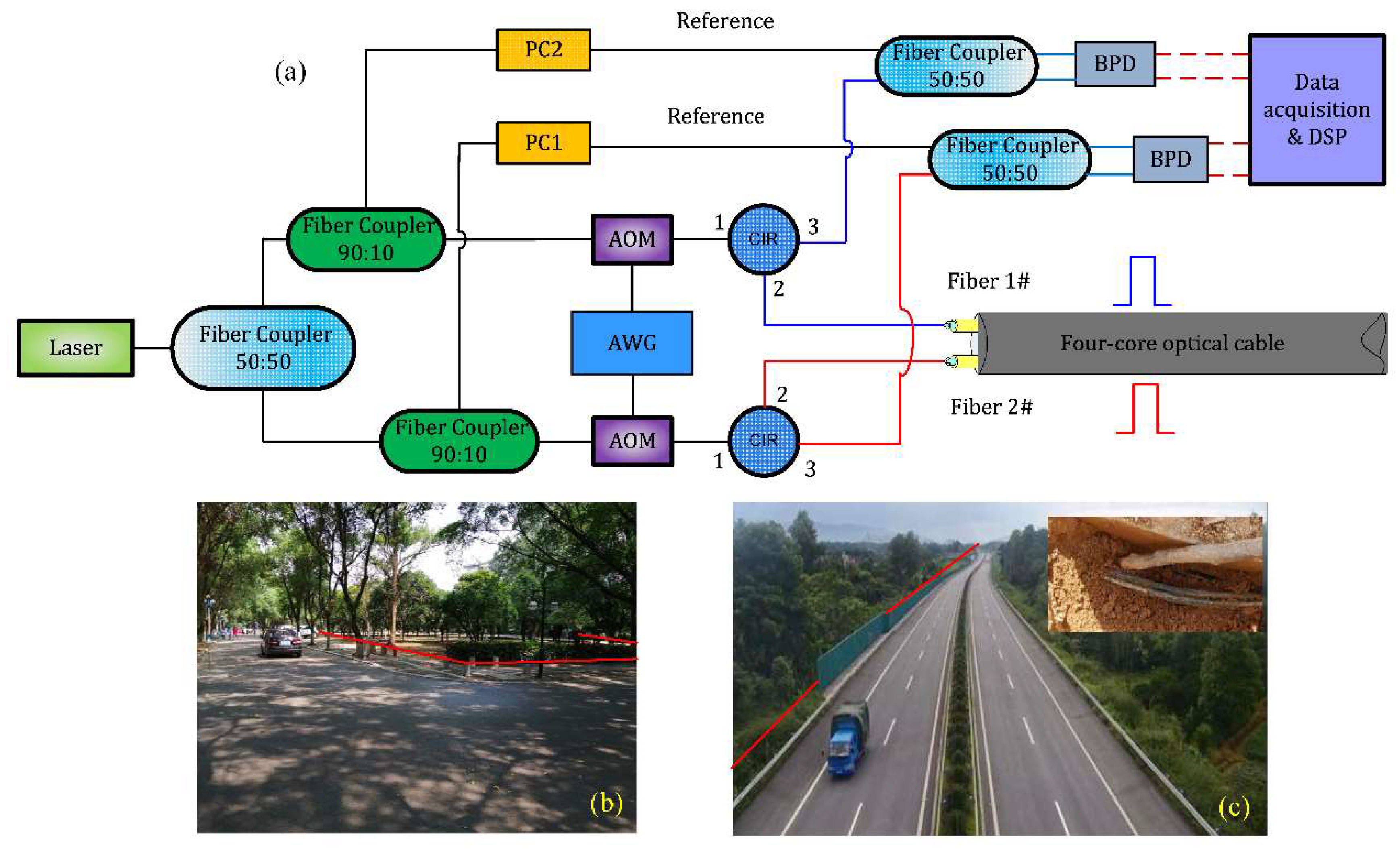
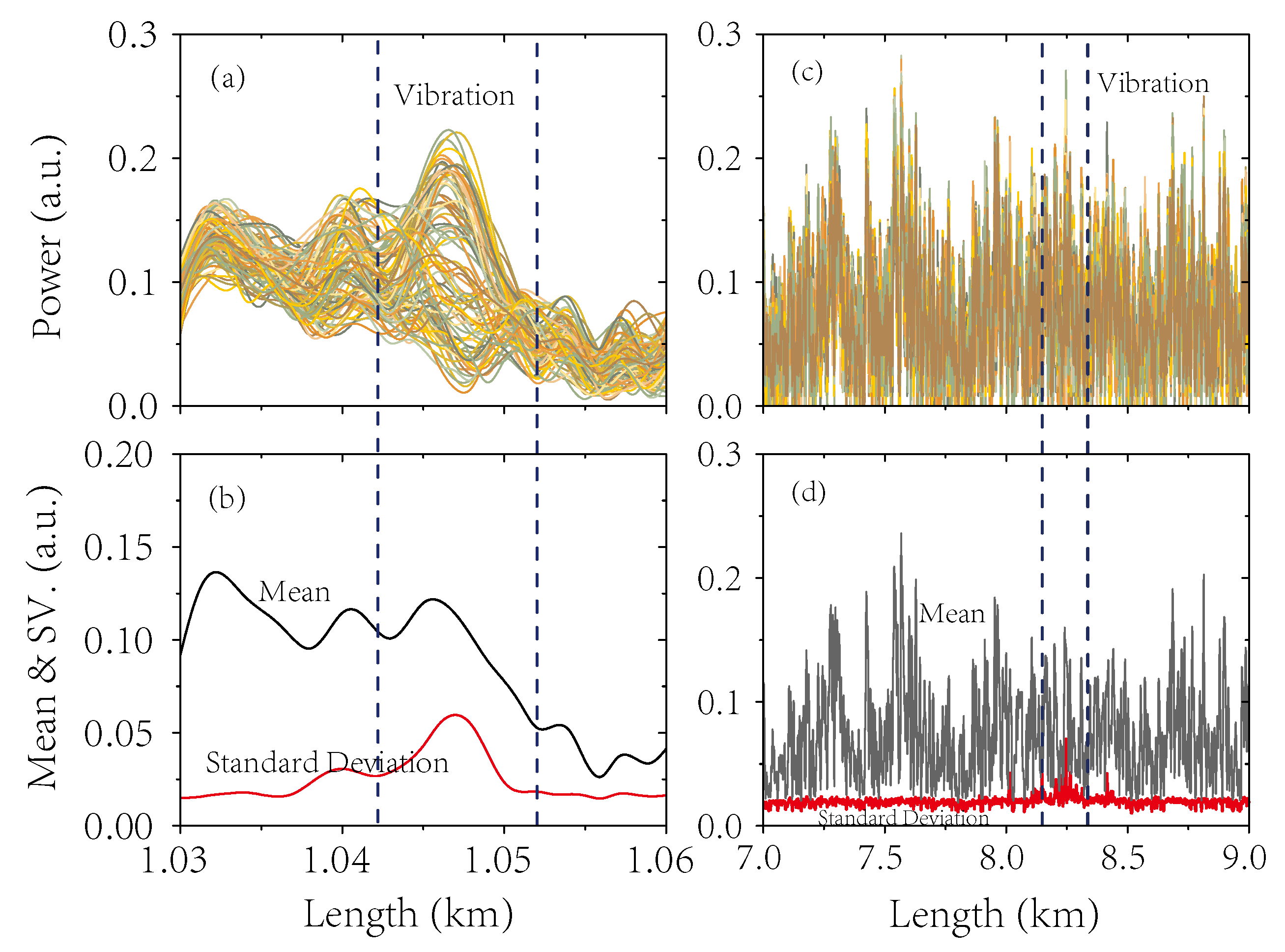
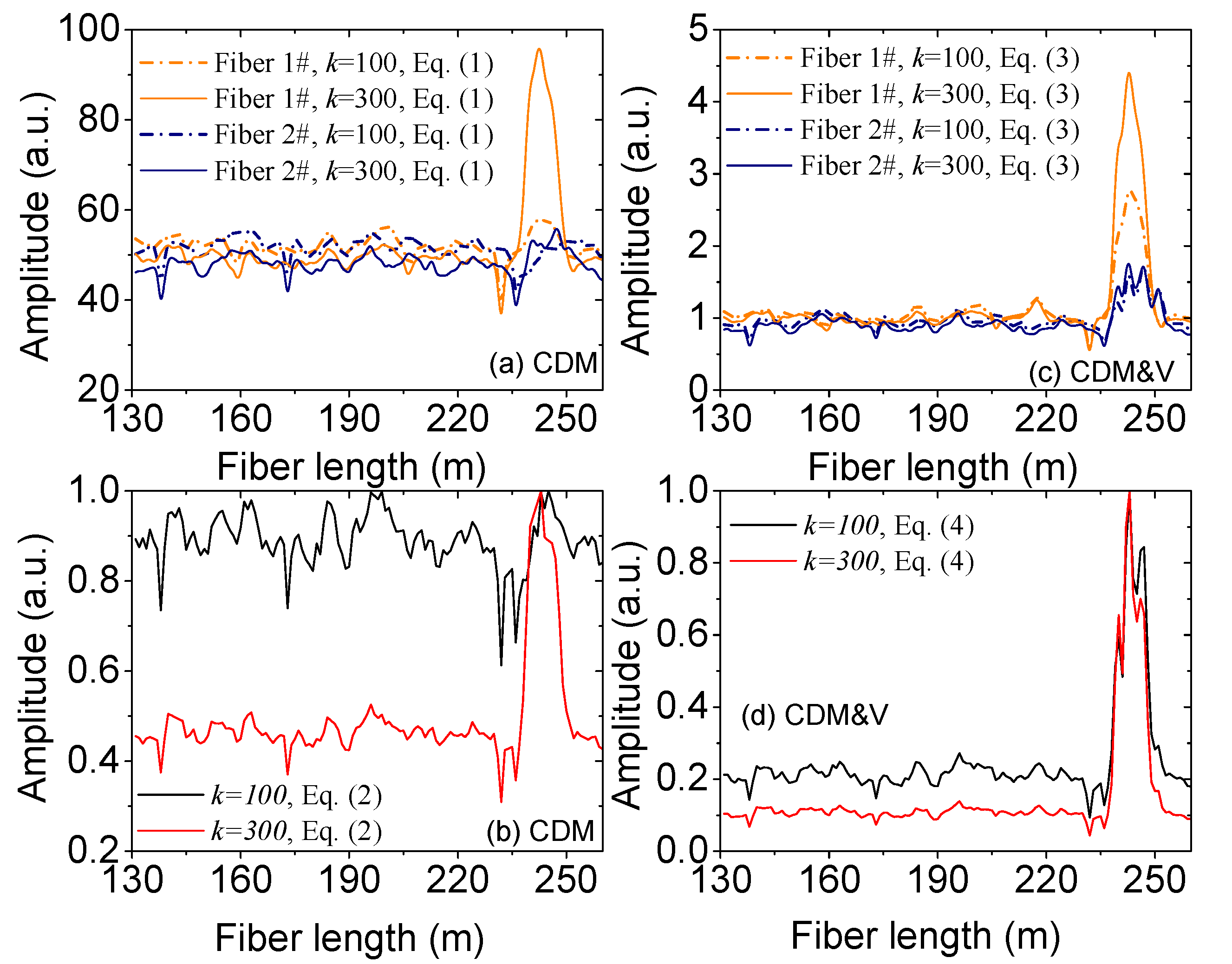
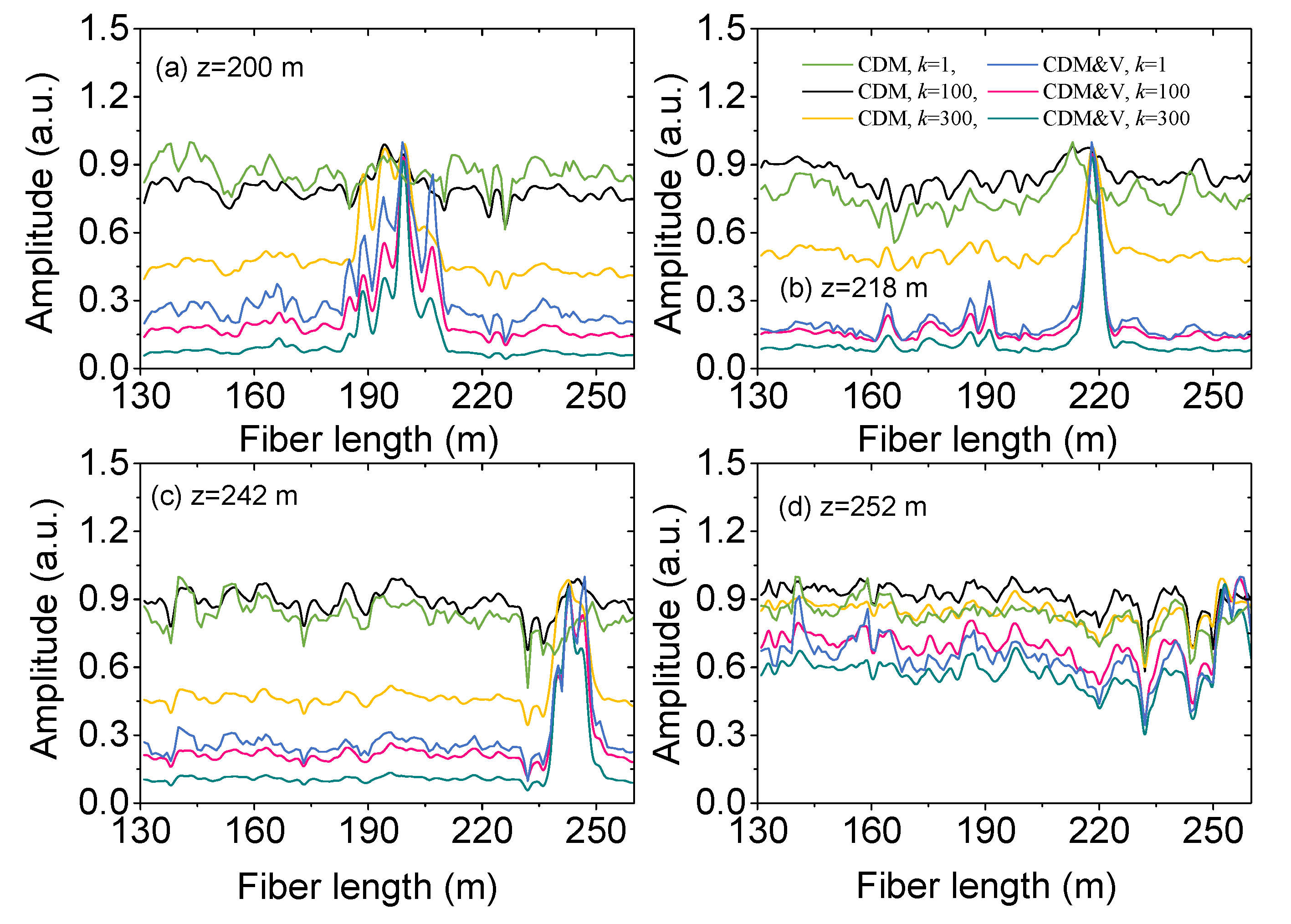
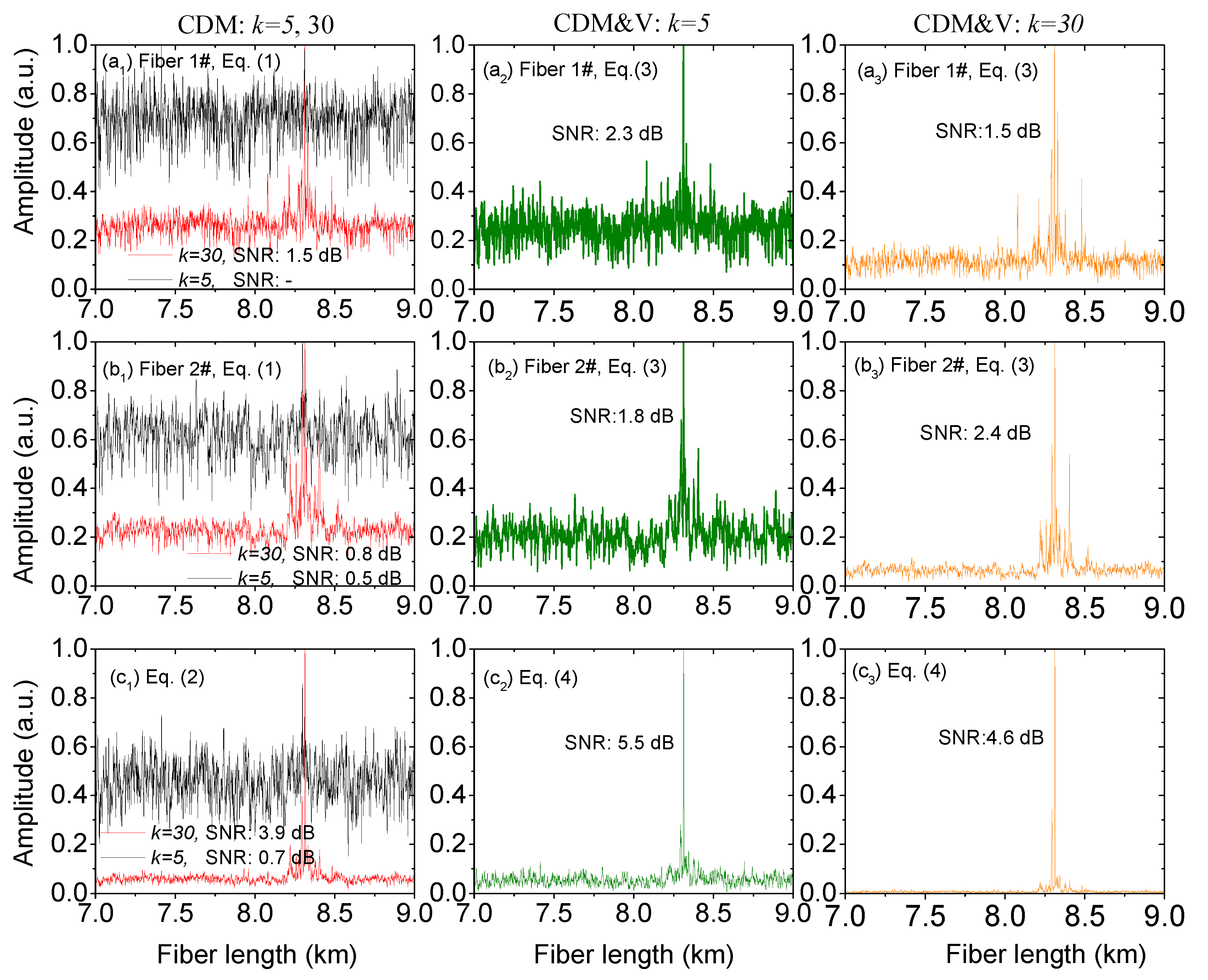
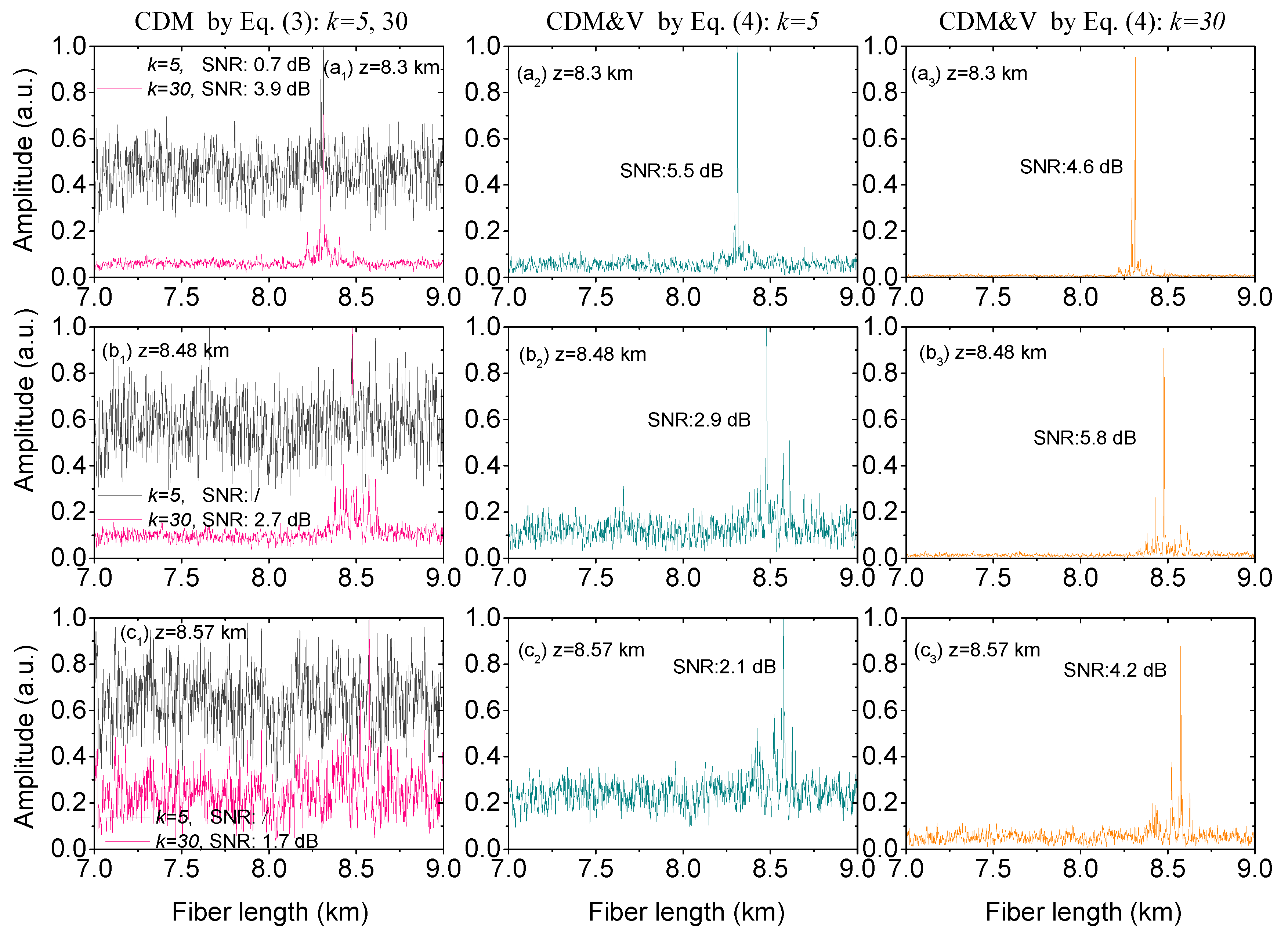
| SNR | k | Fiber 1# | Fiber 2# | (Fiber 1#) × (Fiber 2#) |
|---|---|---|---|---|
| CDM | k = 1 | / | / | / |
| k = 100 | / | / | / | |
| k = 300 | 2.6 dB | / | 3.0 dB | |
| k = N/2= 1250 | 3.5 dB | / | 7.8 dB | |
| CDM&V | k = 1 | 2.4 dB | / | 4.5 dB |
| k = 100 | 3.3 dB | / | 5.7 dB | |
| k = 300 | 5.5 dB | / | 8.5 dB | |
| k = N/2 = 1250 | 5.9 dB | / | 13.9 dB |
| SNR | k | Fiber 1# | Fiber 2# | (Fiber 1#) × (Fiber 2#) |
|---|---|---|---|---|
| CDM | k = 1 | / | / | / |
| k = 5 | / | 0.5 dB | 0.7 dB | |
| k = 30 | 1.5 dB | 0.8 dB | 3.9 dB | |
| k = N/2 = 50 | 1.8 dB | 1.5 dB | 5.5 dB | |
| CDM&V | k = 1 | 1.8 dB | 1.7 dB | 2.3 dB |
| k = 5 | 2.3 dB | 1.8 dB | 5.5 dB | |
| k = 30 | 1.5 dB | 2.4 dB | 4.6 dB | |
| k = N/2 =50 | 3.6 dB | 3.8 dB | 7.9 dB |
| SNR | k | z = 8.30 km | z = 8.48 km | z = 8.57 km |
|---|---|---|---|---|
| CDM | k = 5 | 0.7 dB | / | / |
| k = 30 | 3.9 dB | 2.7 dB | 1.7 dB | |
| CDM&V | k = 5 | 5.5 dB | 2.9 dB | 2.1 dB |
| k = 30 | 4.6 dB | 5.8 dB | 4.2 dB |
© 2020 by the authors. Licensee MDPI, Basel, Switzerland. This article is an open access article distributed under the terms and conditions of the Creative Commons Attribution (CC BY) license (http://creativecommons.org/licenses/by/4.0/).
Share and Cite
Xu, S.; Qin, Z.; Zhang, W.; Xiong, X. Monitoring Vehicles on Highway by Dual-Channel φ-OTDR. Appl. Sci. 2020, 10, 1839. https://doi.org/10.3390/app10051839
Xu S, Qin Z, Zhang W, Xiong X. Monitoring Vehicles on Highway by Dual-Channel φ-OTDR. Applied Sciences. 2020; 10(5):1839. https://doi.org/10.3390/app10051839
Chicago/Turabian StyleXu, Shaohua, Zujun Qin, Wentao Zhang, and Xianming Xiong. 2020. "Monitoring Vehicles on Highway by Dual-Channel φ-OTDR" Applied Sciences 10, no. 5: 1839. https://doi.org/10.3390/app10051839




